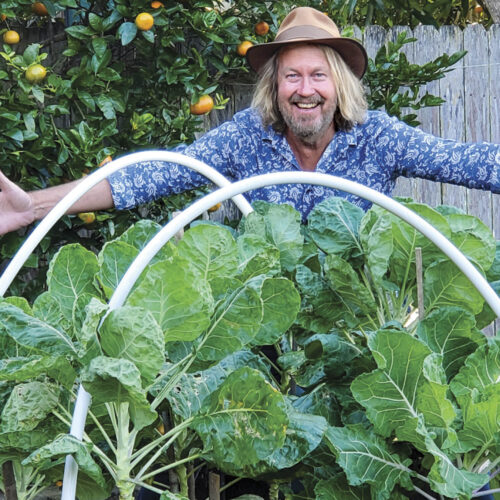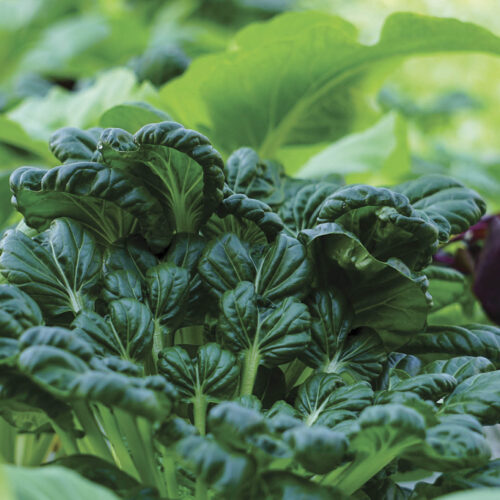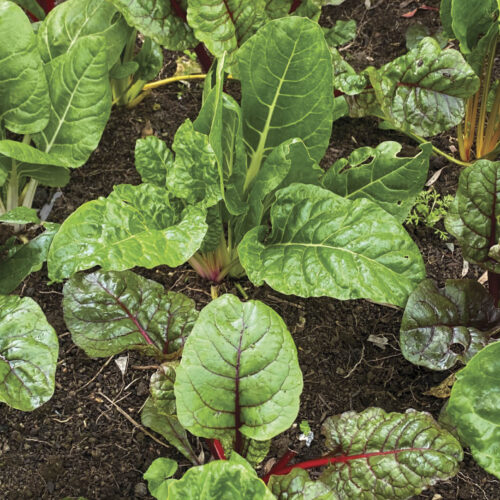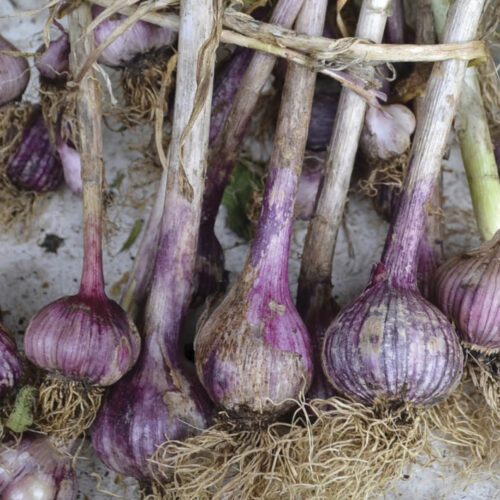Peter Cundall’s top three survival foods
2012-08-19T08:19:09+10:00
PETER CUNDALL serves up some old-school staples. What he calls his “top three survival foods” - potatoes, beans and carrots.
Of all the vegetables grown throughout the temperate climates of the Western world, three of my favourites stand out as the most popular, easily grown and particularly nourishing.
Together or separately, potatoes, beans and carrots provide a wide range of complex carbohydrates, vitamins and minerals. This is why they are now incredibly significant survival foods. These top three veg can be grown in most soils and thrive in all but the most extreme climatic conditions. They can also be stored for long periods. If you are going to choose any vegies to keep yourself and your family fed, these would be the three.
Super spuds
For me, potatoes are the supreme survival food, grown for thousands of years by the native people of the temperate Andes of South America. Hundreds of years ago, Portuguese and Spanish explorers brought potato samples back to begin the first European crops. Today, a vast number of people throughout the world still depend on potatoes as a major source of their food.
Potato plants are perennials, related to tomatoes, capsicums and eggplants. These tubers are an easily digestible and superb source of carbohydrates, low-cholesterol starch and fibre, which satisfies feelings of hunger. The bulky fibre also provides resistance against colon cancer.
Potatoes – with skins left on – are an excellent source of minerals such as potassium, with valuable traces of copper, manganese and iron, in addition to vitamins C, B6, niacin and thiamin. Note, though, that the foliage and green fruit are poisonous.
In the right conditions, potato plants can be hugely productive, producing around seven to 15 mature potatoes for every seed potato planted, depending on climate and variety. In a temperate garden, just eight square metres of enriched soil can produce more than 300 kilograms of tubers. In the subtropics, the yield will be much less. Last spring in my Tassie garden I planted several potato varieties in just two 20-metre-long rows, one metre apart. They produced at least half a tonne of perfect spuds with very little work.
Potato plants can also be easily grown in tubs, troughs and grow-bags or beneath enriched straw without cultivation.
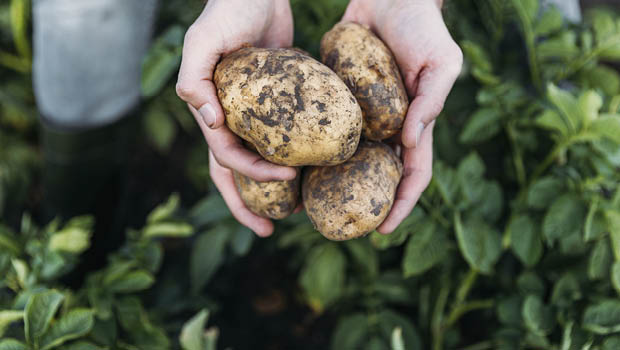
When to plant
Potatoes can be grown in frost-free districts year-round, although tubers cannot form if soil temperatures exceed 25°C. Spuds succeed best when daytime maximum temperatures are between 16-21°C.
In the subtropics this means it is best to plant during late autumn.
In the tropics crops are best grown in cool, mountainous districts. In cooler climates planting can begin from early winter, while in frosty districts tubers can be planted from late winter to mid-January.
Food growers in warm climates will find that potatoes grown in the ground are not always dependable because they like cool and well-ventilated conditions. Every part of the potato plant is susceptible to fungal diseases, which are intensified by hot, humid weather.
Growing in the ground
Here’s how to grow your own spuds in garden beds (not raised).
- Choose a sunny, well-drained part of the garden. Clear away all weeds and top growth, then cultivate the soil deeply.
- Spread well-rotted sheep, cow, poultry or horse manure over the dug surface and mix into the soil. Water if necessary and leave for a few days to settle.
- Create 150mm deep trenches (or use a pointed garden stake to make holes the same depth) in rows at least 500mm apart.
- Use only certified disease-free seed potatoes (available from many nurseries and seed suppliers). Most garden centres carry potato varieties suitable for local conditions and with planting instructions.
- Space the tubers 300mm apart along the base of the trenches and backfill. Water deeply if necessary.
The first leaves will emerge within three weeks. As they grow, use a hoe to draw the soil from between the rows, mounding it high around growing stems. Do this several times during the growing period. This keeps pests such as potato moth grub at bay, suppresses weed growth and massively increases yields.
In dry conditions the plants must be regularly watered until growth starts to lose vigour, as the crop matures. This is when all watering must cease, otherwise the tubers will rot. Early harvests of tasty spuds can be dug out as soon as the plants start flowering.
Garden-less spuds
Where garden space is limited or non-existent, potatoes can be grown on sunny paths, patios or balconies using bottomless garbage bins, large tubs or 40-litre tree bags. Simply bury two or three seed tubers under a 150mm layer of enriched potting soil at the base of each. When the leaves are 300mm above the surface, add more moist soil so only the leaf tips are showing. Continue doing this until the containers are almost full. Yields of up to 15 kilograms of well-sized potatoes can be achieved from a cheap plastic garbage bin.
The straw method
Wasteful, non-productive lawns can be converted into potato patches by using the straw method. Mow all grass or weeds hard, place out the seed potato tubers in rows over the surface and cover with a 500mm-thick layer of straw or hay.
Then weigh the lot down with a 200mm-thick layer of matured sheep or pulverised cow manure. Add an extra 50mm layer of poultry manure pellets and lots of mushroom compost. Water heavily with weak seaweed concentrate and diluted fish emulsion to saturate. From then on keep the rotting, enriched layers moist. There is no digging or weeding and watering is reduced. Potato foliage quickly pokes through the moist mulch and excellent crops of clean potatoes can be easily harvested by lifting the decomposed ‘carpet’ to expose them as the plants mature and foliage dies back.
The best of beans
Green bean pods are a good source of vitamins A and C, folate and iron, while dried beans become outstanding sources of nutrients, being rich in carbohydrates, proteins, fibre, folic acid, magnesium, phosphorus, potassium and iron.
A bean is a name collectively applied to a diverse group of large, seeded crop plants belonging to the Fabaceae family. There are beans for every purpose. They can be eaten fresh as green tender pods, freshly shelled or dried for extra long storage. These are among the most valuable of all foods because they are an amazing source of nutrition, and dried beans store well – sometimes for years – without refrigeration.
Most bean plants need warm conditions to grow properly. Exceptions are broad bean (Vicia faba) varieties, which insist on cold winters and crop heavily during spring and early summer.
Bush and climbing beans (Phaseolus spp.) can be grown for most of the year in warm, dry tropical districts but need a warm start in most cool and temperate regions. In southern Australia the best sowing times are from late October through to early January.
All beans prefer a soil enriched with decomposed organic matter and low-nitrogen fertilisers such as sheep, cow or well-rotted horse manure. These should be deeply dug in as the roots of some bean plants, such as the runner bean (P. coccineus), delve deeply into the soil.
A deep, well-drained, sweet (slightly alkaline) soil and full sunlight is ideal. Acidic soils are best sweetened with lime, preferably the previous autumn or winter.
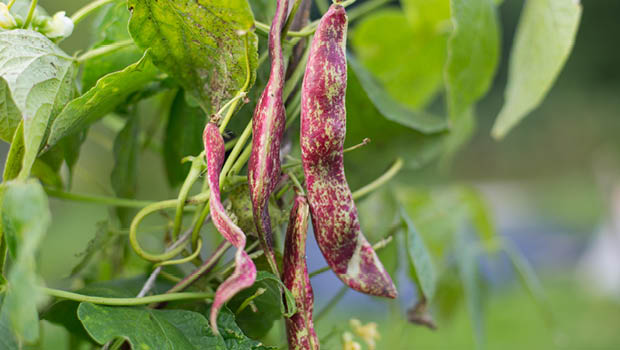
Climbing and runner beans
All climbing beans need supporting frames, which can be easily made using extra long
garden stakes or bamboo. Several stakes or poles may be driven into the ground then tied
together at the top to form a pyramid. Rough climbing frames can also be constructed from stakes or bamboo lengths laced together. Bean seeds are pushed into the soil, 20mm apart around the bases of the supporting frames and then later thinned to twice that distance.
After sowing, water well. Then wait until seedlings emerge before watering further as, at this stage, soil that is too wet can encourage root and stem rot.
The best-flavoured runner beans are ‘Scarlet Runner’ beans. They are sometimes called ‘Seven Year’ beans because, being perennials, the roots may be left in the ground over winter to start another crop each spring. However, seeds are still best as yield decreases with age.
‘Scarlet Runner’ bean plants carry thick, long coarse-looking pods that are tender and delicious to eat. Flowers are bright scarlet, although there are white-flowered and bicolor forms like ‘Painted Lady’. However, these flowers only set pods in cool districts where night temperatures drop below 15ºC. Keen gardeners in warmer districts claim improved results after spraying flowers with iced water each evening.
Alternative climbing or pole beans for warm districts include ‘Blue Lake’ and ‘Mammoth Golden Cluster’, which carries huge crops of golden pods in great clusters. ‘Purple King’ is a strong-growing plant with bright purple pods that turn green when cooked. Sown in late autumn to late winter, ‘Purple King’ and green-podded ‘Epicure’ are very reliable in warm temperate and subtropical climates.
Dwarf beans
Dwarf or ‘bush’ beans (P. vulgaris) are best sown 100mm apart and staggered to form double rows. This provides good, mutual support as they tend to become top-heavy with the weight of the pods. Alternatively, these can be grown along the edge of raised beds where their floppy growth habit is not a problem.
As they grow, push dry straw under them to suppress weeds and seal in moisture while keeping pods clear of the soil. In frost-free climates, use only a veneer of mulch to prevent collar rot. As the pods mature, keep picking to prevent the seeds inside from forming. When this occurs, pod production stops.
Most bush bean pods can be left to fully mature and dry off. They are excellent as dried beans, although most need to be soaked overnight before cooking. Dried varieties such as the ‘Yin-Yang’ patterned or the beautifully speckled ‘Borlotti’ also produce tasty, stringless young pods. These dried beans are perfect for salads, soups, stews and casseroles.
Carrots with crunch
One reason carrots are packed with nutrients is because they are tap roots that probe deep into the mineral-rich sub-soil. They contain more of the antioxidant carotene – which humans convert into vitamin A – than almost any other food source.
Carrots are packed with minerals such as iron, magnesium and potassium, and are a good source of vitamin C, niacin and folate. The absorption of the protective beta carotene is increased by slightly cooking or finely pulverising.
In a cool temperate climate, just three square metres of ground can grow enough carrots to provide for most families’ needs. The most productive regions where carrots are grown commercially in Queensland are inland highland areas, such as ?the Atherton Tablelands, east of Mackay and around Roma and the Darling Downs.
Carrot plants need few fertilisers. In fact, seeds are best sown into soil that has been fertilised a couple of seasons previously for other vegetables.Carrots can be grown in ?all soils except heavy clay. Finely cultivated, deeply watered, deep sandy or sandy loam soils produce the best crops as they encourage the formation of the longest roots. However, over-rich soil and fertilisers containing nitrogen can cause wasteful forking.
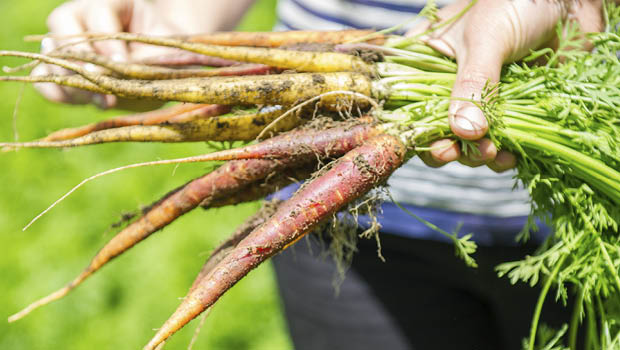
Growing carrots
Carrot seed can be sown from about March to September in warmer climates, and from August to mid-March in cool areas. It takes around eight weeks to first harvest, with some varieties taking much longer. In cool climates, late-sown crops are ready to eat by June and can be stored in the ground for winter pulling until they bolt in November. By this time, early crops are maturing, giving valuable overlaps.
- Prepare the ground by deep forking, rake to an even tilth and, if dry, water deeply. Then leave for a day or two.
- Press a rake handle or garden stake into the surface to create straight grooves, wide enough apart so the soil between can be raked to disrupt weed seedlings.
- Mix seed with sand and sprinkle along the grooves. Backfilling is unnecessary after watering the seed bed, but keep the soil constantly moist until germination.
- When seedlings emerge, thin to leave 50mm spaces between those remaining. If necessary, protect from birds and animals by using bird-wire tunnels.
We have many more features about planting vegies but for starters try these:


